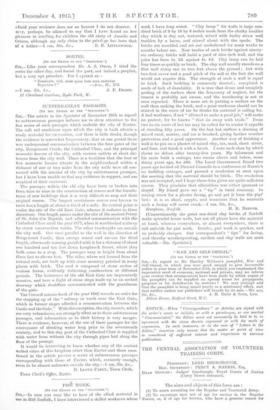PISS WORK.
ITO THE EDITOR 05 THE " SPECTATOR."]
Ssn,—In ease you may like to hear of the allied material in use in Mid-Norfolk, I have interviewed a skilled workman whose
work I have long noted. " Clay lump " for walls is large suns dried brick of fl by 18 by 6 inches made from the chalky boulder clay which is dug out, watered, mixed with barley straw well trodden by a horse, and stirred about with the spade. The bricks are moulded and set out unsheltered for some weeks to months before use. Now twelve of such bricks against ninety- six ordinary bricks will build a yard of nine-inch wall, and the price has been Is. 3d. against 4s. 6d. Clay lump can be laid four times as quickly as brick. The clay wall usually stands on a flint wall rising one to two feet above the ground ; but with two-foot eaves and a good pitch of the soil at the foot the wall would not require this. The strength of such a wall is equal to brick- Such building is commonly decried ; complaint is made of lack of durability. It is true that decay and unsightly peeling of the surface show the frequency of neglect, for the tenant is probably not owner, and the weathering is not at once reported. There is more art in putting a surface on the wall than making the brick, and a good workman should not be stinted in the coats of tar he thinks his material is calling for. A bad workman, if not " allowed to make a good job," will make no protest, for he knows " that do away with trade." From two to six coats of hot tar may be called for to render it capable of standing fifty years. On the last hot surface a dressing of mixed sand, mortar, and tar is brushed, giving further weather protection and a good appearance. Another way of finishing a wall is to put on a plaster of mixed clay, tar, sand, short straw, and lime, and finish it with a brush. I note such close by which shows no defect after twenty-five years. My informant and his mate built a cottage, two rooms above and below, some thirty years ago, for £00. The Local Government Board two years ago invited all District Councils to a conference at Norwich on building cottages, and pressed a resolution at once upon the meeting that the material should bo brick. The resolution was not accepted, and I hope these data given are quite sufficient season. They proclaim that officialdom was either ignorant or stupid. My friend gave me a " tip " in rural economy. In mixing straw for a plaster facing, go and get it from the pigs' bed : it is so short, supple, and tenacious that he warrants such a facing will never crack.—I am, Sir, &c., [Unquestionably the great sun-dried clay bricks of Norfolk make splendid house walls, but not all places have the material at hand, whereas everywhere, or almost everywhere, there is soil suitable for piste work. Besides, pis() work is quicker, and so probably cheaper. Our correspondent's " tips " for facing, and thereby weatherproofing, earthen and clay walls aro most valuable.—En. Spectator.]




















































 Previous page
Previous page